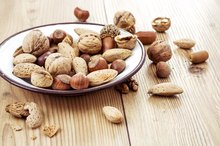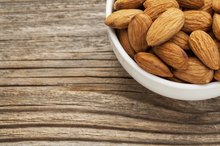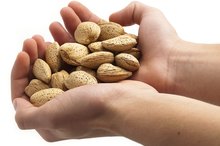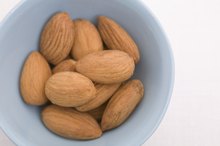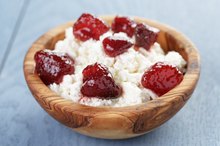Phytic Acid in Almonds
The U.S. Department of Agriculture Food Pyramid recommends you include nuts as a source of protein in your diet. Almonds, classified as a tree nut, contain many vital nutrients, which has fueled the craze for almond food products such as almond milk and almond butter. Although packed with nutrients, you should temper your desire for this tasty snack, as almonds also contain a high calorie count, fat and phytic acid – a substance that can inhibit the absorption of some nutrients.
Phytic Acid in Almonds
Phytic acid, a substance naturally found in plants, serves as the principal storage molecule for phosphorus – a nutrient important for the transport of energy and the function of other vitamins. Phytic acid combines with other minerals to form a salt known as phytate. Wheat bran and flaxseeds contain the highest content of phytic acid, but this nutritionally controversial substance is also found in other grains, seeds, beans and nuts. Almonds contain approximately 363 mg of phytic acid per 1 oz. of nuts, which consists of about 23 nuts.
Effects of Phytic Acid
The Nutrition of Smoked Almonds
Learn More
The nutritional effects of phytic acid remain a topic of controversy. Information provided by Phytochemicals states that phytic acid acts as an antioxidant. Antioxidants are substances that protect cells from the damaging effects of free radicals, the negatively charged particles produced during normal biochemical reactions in the body. As an antioxidant, phytic acid may help protect against certain types of cancer and high blood cholesterol. Phytic acid also easily binds with other minerals, including zinc, calcium, iron and magnesium. Eating foods high in phytic acid, like almonds, can interfere with the absorption and use of these minerals and lead to a nutrient deficiency.
Almond Nutrition
A 1 oz. serving of almonds contains 160 calories with 14 g of fat, according to the International Tree Nut Council Nutrition Research and Education Foundation. Although high in fat, the majority of fat is classified as monounsaturated and polyunsaturated, the types of fat the American Heart Association recommends to help keep cholesterol levels low. Almonds also serve as a good source of vitamin E, a powerful antioxidant, providing 35 percent of your daily recommended intake per ounce. So although almonds contain phytic acid, which may inhibit the absorption of other minerals, they do make a healthy snack when eaten in moderation.
How to Remove Phytic Acid
Do Nuts Have Folic Acid?
Learn More
For those worried about the phytic acid content of almonds, you can take steps to remove the majority of phytic acid prior to eating them. Soak your almonds in salt water overnight, then dry them out by placing in a warm oven, a dehydrator or a warm sunny spot until completely dry. The salt water removes the phytic acid and enhances the flavor and texture of the nut. To produce almond milk, a milk-like drink that many use to replace cow’s milk, you must soak the almonds so that the milk contains little phytic acid.
Related Articles
References
- Phytochemicals: Phytic Acid
- The International Tree Nut Council Nutrition Research and Education Foundation; Almonds; 2010
- J Zhejiang University Science; Phytate: Impact on Environment and Human Nutrition; Bohn et. al.; March 2008
- USDA Center for Policy and Promotion; The Role of Nuts in a Healthy Diet; December 2000
- U.S. Department of Agriculture: Food Pyramid – Protein
- Almond Board of California: The Fight Against Free Radicals
Writer Bio
Stephanie Chandler is a freelance writer whose master's degree in biomedical science and over 15 years experience in the scientific and pharmaceutical professions provide her with the knowledge to contribute to health topics. Chandler has been writing for corporations and small businesses since 1991. In addition to writing scientific papers and procedures, her articles are published on Overstock.com and other websites.

